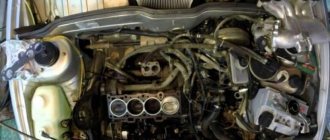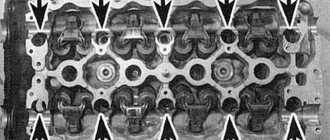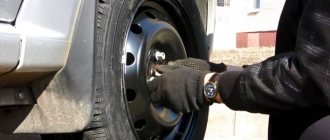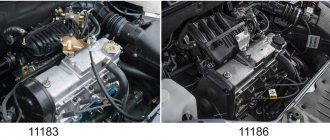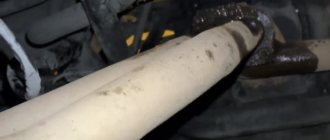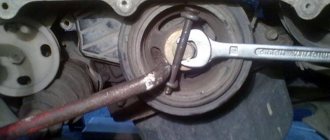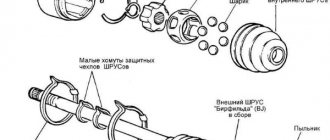Car enthusiasts often encounter the problem of oil leaking from under the engine head. This occurs due to wear of the gasket, which causes the bolts to become loose. Let's look at what tools are needed to perform car maintenance. We will also analyze the tightening torque of the VAZ 2114 cylinder head (8 valves) and how to work correctly with a torque wrench.
Useful video:
Required Tools and Process
From time to time, the cylinder head gasket may fail due to wear and tear of its material or burnout. The main signs that it is time to replace the gasket with a new one are the appearance of local leaks of oil and coolant at the point of contact between the cylinder head and the engine. Tightening torque of the cylinder head VAZ 2114 8 valves: consider the subtleties of the process.
It should be remembered that when replacing a gasket, not only the tightening torque of the VAZ 2114 cylinder head is important, but also the entire sequence of operations - after all, the replacement itself is a very important and serious procedure, errors during which can lead to engine malfunction.
In order to do it correctly, you will need:
- set of socket heads;
- extension;
- ratchet/wrench;
- torque wrench.
The replacement process itself should be performed according to the following scheme:
- Disconnect the wires leading to the emergency oil level and coolant temperature sensors.
- Drain the coolant.
- Remove the thermostat.
- Remove the air filter housing.
- Disconnect the exhaust pipe inlet from the manifold.
- Remove the casing, as well as the camshaft belt itself.
- Disconnect the drive rods of both dampers from the carburetor.
- Disconnect the wires going to the cylinder head.
- Disconnect the hoses suitable for the cylinder head by loosening their clamps.
- Remove the cylinder head.
- Remove the worn gasket.
- Clean the contact surface of the cylinder head from any remaining gasket material.
Installing the gasket and mounting the cylinder head in place is carried out in exactly the same sequence, but in reverse order. At the same time, it is worth paying close attention to such a factor as the tightening torque of the cylinder head of the VAZ 2114 8 valves - we will talk about it below.
What is he like?
The phase sensor operates on the principle of an elementary Hall sensor. Installed only in the camshaft area on both 8 and 16 valve engines. The device reads data from the engine camshaft using a gear mounted on the shaft with two missing teeth. These two teeth are positioned so that every time the device is hit, the first piston of the engine is at top or bottom dead center. Information signals about the location of the camshaft are sent to the engine control unit, which, in turn, monitors and changes the ignition angle. It began to be used at VAZ factories on the first cars with distributed fuel injection.
It is worth noting that carburetor engines do not have this unit, because their ignition timing system is vacuum-mechanical.
The main function of the camshaft position DF or phase sensor is to constantly adjust the ignition angle while the engine is running. Thanks to its use, VAZ family engines began to transmit power more efficiently with reduced fuel consumption. The main indispensable use of the phase sensor remains for two camshaft, 16-valve engines, which without it cannot operate evenly and economically according to the folded factory design.
How to tighten cylinder head bolts correctly?
Before you begin installing the cylinder head, you should first pay attention to the condition of its bolts. They must have a good thread and the length meet the required standards.
The normal overall length of the cylinder head bolt is 135.5 mm. If the bolts removed during gasket replacement meet this parameter, they can be reused. If the bolts have lengthened during engine operation, then they can no longer be used and new ones should be purchased.
Having dealt with the bolts in this way and installing them in place, you should proceed to tightening. It must be done only with a torque wrench. Tightening bolts “by eye” can lead to very serious consequences, including damage to the engine itself.
And so, how to stretch the head onto a VAZ 2114 correctly? Firstly, you should remember that you should start tightening the bolts from the center to the edges.
Secondly, tightening should be done in four stages (each of which is performed in exactly the same sequence as indicated in the diagram above).
At the first stage, we tighten each of the bolts with a torque wrench with a force equal to 2 kgf/cm2.
At the second stage, we tighten all the bolts with a force of 8 kgf/cm2.
At the third stage, we tighten the bolts, turning each of them at an angle of 90 degrees.
At the fourth stage, we again turn each of the bolts (still following the diagram given at the beginning) at an angle of 90 degrees.
Once all four steps are completed, tightening the cylinder head bolts can be considered complete.
The tightening of cylinder head bolts should be taken as seriously as possible. All its stages must be performed strictly in the same order and with equal effort at each of them. Failure to comply with this rule can lead to rapid wear of the gasket and the appearance of oil and coolant leaks.
conclusions
Replacing the head gasket on a VAZ-2114 is quite difficult, since you need to know the design features of this engine, as well as have experience in performing such operations on similar engines.
The choice of gasket should be approached seriously and carefully, since the normal operation of many components depends on its condition. If the process described in the article seems quite complicated and the motorist is not able to carry out the operation on his own, then it is recommended to contact a car service center, where they will help and do everything quickly and efficiently.
Gasket selection
The product must meet the following properties:
- elastic deformation, which will not allow the gasket to wear out quickly;
- impermeability of liquids - water and engine oil;
- resistance to gases;
- maintaining its characteristics over time;
- resistance to various chemical influences.
In case of burnout, in accordance with the technical manual, to ensure the working condition of the mechanism, only original gaskets must be used.
The article number for this product is 21083-1003020. The dimensions of this gasket are optimally designed for installation in the seats on the VAZ 2114 head. The product is manufactured at the AvtoVAZ plant. You can use analogues from manufacturers Patron, Rains, Master-Sport, Trialli, etc. The cost of some similar products can be 2-3 times higher than the original.
An overview of the faulty gasket and the procedure for solving the problem is shown in the video published by the KV Avtoservis channel.
Tightening torque of the cylinder head VAZ 2114 8 valves: correct operation with a torque wrench
A tool such as a torque wrench, which allows you to tighten bolts with equal force, requires great care in operation and certain skills.
An approximate sequence for tightening bolts with this wrench is as follows:
- set the holder to the “zero” position;
- begin smooth rotation of the instrument, while simultaneously monitoring its readings;
- if the tool rotates (especially at the initial stage of tightening) without changing the torque on the indicator, this may indicate a slight internal stretch of the fasteners. This phenomenon is absolutely normal and the rotation of the tool should be continued;
- When the tightening torque corresponding to the required one is reached, the movement of the tool should be stopped.
Instead of using a torque wrench, you should not use any other tool (including a mechanized one, with the ability to regulate the tightening force). After all, only with a wrench can you achieve absolutely precise and smooth tightening of the bolts, thanks to which the gasket will be evenly pressed over the entire surface of the block. This will help maximize its service life, avoid burnouts, oil leaks and coolant leakage.
Procedure for replacing the cylinder head gasket on a VAZ 2109-2108
The gasket may remain either on the surface of the head or stick to the block itself. You can try to remove it by hand without using any tools, and if that doesn’t work, you can carefully pry it off with a flat-head screwdriver without damaging the surface of the part.
The engine block also needs to be cleaned and then a new gasket installed on it.
Of course, it will be necessary to first carry out some preparatory procedures, without which it will be impossible to remove the head.
- First, you need to remove the air filter housing
- Then disconnect all fuel hoses and power wires from the carburetor or injector (depending on the type of engine)
- , although this is not a prerequisite - it will be enough to disconnect the high-voltage wires
In general, it is necessary to free the head from everything unnecessary so that during dismantling there are no unnecessary problems. Of course, if you decide to completely replace it or repair it, then you will have to perform more operations, both the carburetor and the manifolds. Well, if it’s just a matter of gasketing, then you can get by with a minimum of actions.
Work order
Before tightening, you will have to get to the block head. This can be done no earlier than after disassembling a good half of the engine.
First, open the connectors, the connecting wires leading to the antifreeze temperature sensors and the oil level control sensors. Once done, drain the coolant. It is necessary to dwell on this important point separately. Be careful - the composition mentioned above is quite toxic, so it is better to work with gloves. To collect coolant, prepare a container with a volume of at least 9 liters.
To drain the fluid, open the distribution tank, and then unscrew the plug located directly on the cylinder block. When the leak stops, move the container to the radiator - there is a separate drain here. After removing all the antifreeze, screw on the caps.
- remove the thermostat, and behind it the air filter;
- disconnect the exhaust pipe from the manifold;
- Remove the protective housing and the belt from the VAZ camshaft;
- The throttle valve drive cables must be separated from the carburetor;
- remove all cables leading to the cylinder head, as well as tubes, hoses, etc. (be sure to loosen the clamps that secure them, otherwise you won’t be able to move them to the side).
You now have direct access to the head. Unscrew all the bolts holding it, and, using the help of a partner, remove the cylinder head. After this, tear off the old gasket.
Carefully clean the rear surface of the VAZ 8-valve engine block from dirt and adhered fragments of the sealing element material. Sand it with fine sandpaper - you should be left with a completely smooth, matte base. At the same time, check all valves and seals.
Be sure to remove any oil or debris from the bolt holes. Lubrication helps reduce the friction force, which in this case is fraught with many troubles, and foreign fragments will not allow reliable fastening.
All that remains is to install a new gasket and reinstall the VAZ-2114 cylinder head. This is where the time comes to talk about what tightening torque is required.
Cars VAZ-2115i-14i-13i
The tightening torques for threaded connections on VAZ-2115 (2113, 2114) vehicles are given in the table below.
- The given values of tightening torques for threaded connections can be rounded to tenths within the tolerance.
- The cylinder head mounting bolts must be tightened in four steps: 1 – to a torque of 20 Nm (2 kgf); 2 – torque 69.4–85.7 (7.1–8.7 kgf); 3 – turn 90°; 4 – turn it 90° again.
Tightening torque, Nm (kgf-m)
Procedure for replacing the cylinder head gasket on a VAZ 2109-2108
At the end of the operational period or if the integrity of the cylinder head gasket is damaged, the element must be replaced.
The main sign of a malfunction or gasket wear is the formation of coolant and oil leaks at the junction of the engine block and the cylinder head.
Cylinder head seals
Replacement
To change the gasket, you will need to dismantle the assembly, get rid of the worn cylinder head gasket and reassemble the structure in the reverse order, following the recommendations regarding the tightening torques of the cylinder head bolts. We will tell you about all this in more detail.
Cylinder head seals
If you detect a leak of engine oil or coolant at the junction of the head and the cylinder block, remove the head and replace its gasket. A leak can also occur due to warping of the block head due to overheating.
You will need: a torque wrench, keys “13”, “17”, “19”, socket heads “10”, “13”, “17”, “Togh”, screwdriver.
Warning! The head gasket is a one-time use unit, so the gasket must be replaced each time the head is removed.
1. Disconnect the wire from the “-” terminal of the battery.
2. Set the piston of the 1st cylinder to the TDC position of the compression stroke (see “Installing the piston of the 1st cylinder to the TDC position of the compression stroke”).
4. Reduce the pressure in the power system if the work is performed immediately after a trip (see “Reducing pressure in the power system.”
5. Disconnect the exhaust pipe of the muffler from the exhaust manifold (see “Replacing the exhaust pipe”.
6. Remove the cylinder head cover (see “Replacing the cylinder head cover gasket”).
7. Disconnect the wiring harness block from the mass air flow sensor, loosen the clamp securing the air supply pipe to the throttle body and remove the pipe with the air filter housing and the air intake hose from the throttle body (see “Removing and installing the air filter”).
8. Unscrew nut 1 securing the bracket for the water pump supply pipe. Loosen nut 2 securing the inlet pipe bracket to the exhaust manifold.
9. Move the bracket to the side.
10. Loosen the clamps.
11. ...and disconnect the inlet and outlet hoses of the cooling system from the throttle body.
12. Loosen the clamp securing the vacuum brake booster hose to the fitting on the receiver...
13. ...and remove the hose.
14. Turn the throttle drive sector all the way and disconnect the throttle drive rod from it.
15. Unscrew the two nuts securing the tips of the “mass” wires to the rear cover of the cylinder head...
16. ...and remove the wires from the studs.
17. Unscrew the nut of the lower fastening of the spacer 1 and remove the bolt of the lower fastening of the spacer 2...
18. ...unscrew the nuts of the upper fastenings of the intake manifold struts on the right...
19. ...and on the left side, remove the spacers.
20, Disconnect the wiring harness connectors from the crankcase oil level sensors...
21. ...from the throttle position sensor...
22. ...from the idle air control...
23. ...from the injector wiring harness...
24. ...from the coolant temperature sensor...
25. ...from the crankshaft position sensor and the knock sensor.
26. Disconnect the wire connectors from the coolant temperature gauge sensor...
27. ...and from the oil pressure sensor.
28. Disconnect the high-voltage wire tips from the spark plugs.
29. Pull the wiring harness out from under the receiver.
30. Remove the three screws securing the front camshaft drive belt cover, remove the cover...
Warning! It is forbidden to turn the crankshaft and camshaft before installing the camshaft belt.
32. Secure the camshaft toothed pulley from turning, remove the bolt securing the pulley to the camshaft...
33. ...and remove the bolt and washer.
34. Remove the pulley from the camshaft. Do not damage the camshaft oil seal.
Note. If the key does not sit tightly in the groove of the camshaft nose, remove it so as not to lose it.
35. Unscrew the nut securing the rear camshaft drive cover at the top of the cylinder head.
36. Remove four bolts (three of them also secure the water pump) and remove the rear cover (see “Engine repair (disassembly, troubleshooting, assembly)”).
37. Unscrew the nut securing the “mass” wire...
38. ...and remove the wire from the stud securing the exhaust pipe of the cooling system to the cylinder head.
39. Loosen the clamps and remove the radiator inlet pipe 2, the inlet hoses of the throttle unit 4 and the heater 3 from the outlet pipe, disconnect the thermostat 5 along with hose 1.
40. Unscrew the fastening nuts and disconnect the fuel supply and drain hoses from the fuel pipes, holding the hoses from turning with a second wrench.
41. Please note that there are O-rings installed on the fuel pipes.
After disconnecting each hose, remove the O-ring from the tube. Replace heavily compressed or torn rings.
42. Loosen the ten bolts securing the head of the unit in the order shown, then completely unscrew the bolts securing the head, remove them along with the washers and remove the head.
Note. It is necessary to unscrew the cylinder head mounting bolts using a special socket head “Togh”.
Warning! Do not jam a screwdriver or other tools between the cylinder head and the cylinder block.
Helpful advice. To remove the cylinder head from the gasket, insert a screwdriver under the exhaust manifold. Using it as a lever, lift the head.
43. Remove the head gasket.
Note. The cylinder head bolts become stretched with repeated use. Replace with new bolts longer than 135.5 mm. Before installing the cylinder head, lubricate the bolts with a thin layer of engine oil.
44. Clean the mating surfaces (they must be dry and clean) of the cylinder head and cylinder block and remove oil from the threaded holes in the block for the head mounting bolts.
45. Install a new head gasket on the block (the gasket must be dry and clean) along the installation sleeves so that the hole for the oil passage in the gasket (with copper edging) is between the 3rd and 4th cylinders.
1 - torque 20 N-m (2 kgf-m);
2 - torque 69.4-85.7 Nm (7.1-8.7 kgf-m);
3 - tighten the bolts 90°;
4 - finally tighten the bolts 90°.
47. Install the parts on the cylinder head and connect hoses and wires to it in the reverse order of removal. Install the camshaft pulley with the protruding part of the hub facing the engine.
Check and, if necessary, adjust the clearances in the valve drive (see “Adjusting the clearances in the valve drive”). Adjust the tension of the camshaft drive belt (see “Replacing the camshaft drive belt and adjusting the belt tension”).
. 2115
| Van046 Blog Refinement of the cylinder head of the VAZ classic, ͷ () | ||
| 121,25 | . «» | |
| 8 | 20,87-25,77 (2,13-2,63) | |
| M10x1.25 | 33,23-41,16 (3,4-4,2) | |
| 8 | 18,38-22,64 (1,87-2,31) | |
| M10 | 67,42-83,3 (6,88-8,5) | |
| 6 | 6,66-8,23 (0,68-0,84) | |
| 8 | 15,97-22,64 (1,63-2,31) | |
| M10x1.25 | 68,31-84,38 (6,97-8,61) | |
| 6 | 5,15-8,23 (0,52-0,84) | |
| 91 | 43,32-53,51 (4,42-5,46) | |
| M10x1.25 | 60,96-87,42 (6,22-8,92) | |
| 6 | 7,64-8,01 (0,78-0,82) | |
| 121,25 | 97,9-108,78 (9,9-11,1) | |
| 6 | 4,17-5,15 (0,425-0,525) | |
| 81,25 | 20,87-25,77 (2,13-2,63) | |
| 81,25 | 15,97-22,64 (1,63-2,31) | |
| M10 | 41,65-51,45 (4,25-5,25) | |
| M10 | 41,65-51,45 (4,25-5,25) | |
| M10 | 31,85-51,45 (3,25-5,25) | |
| M10 | 27,44-34 (2,8-3,47) | |
| M12 | 60,7-98 (6,2-10) | |
| 6 | 8,33-10,29 (0,85-1,05) | |
| 6 | 6,86-8,23 (0,7-0,84) | |
| 6 | 8,33-10,29 (0,85-1,05) | |
| 6 | 7,2-9,2 (0,735-0,94) | |
| 161,5 | 45,5-73,5 (4,64-7,5) | |
| 201,5 | 37,48-87,47 (3,8-8,9) | |
| 141,5 | 24-27 (2,45-2,75) | |
| 8 | 12,8-15,9 (1,3-1,6) | |
| 6 | 1,96-4,6 (0,2-0,47) | |
| 121,25 | 54,2-87,6 (5,53-8,93) | |
| 121,25 | 54,2-87,6 (5,53-8,93) | |
| 6 | 3,8-6,2 (0,39-0,63) | |
| 8 | 19,13-30,9 (1,95-3,15) | |
| 8 | 15,7-25,5 (1,6-2,6) | |
| 6 | 4,78-7,75 (0,49-0,79) | |
| 8 | 16,3-20,1 (1,66-2,05) | |
| 6 | 5,1-8,2 (0,5-0,83) | |
| 8 | 15,7-25,5 (1,6-2,6) | |
| 8 | 15,7-25,5 (1,6-2,6) | |
| 201,5 | 120,8-149,2 (12,3-15,2) | |
| 141,5 | 28,4-45,1 (2,9-4,6) | |
| 6 | 11,7-18,6 (1,2-1,9) | |
| 8 | 15,7-25,5 (1,6-2,6) | |
| M10x1.25 | 63,5-82,5 (6,5-8,4) | |
| 6 | 4,5-7,2 (0,45-0,73) | |
| 8 | 15,7-25,5 (1,6-2,6) | |
| 8 | 15,7-25,5 (1,6-2,6) | |
| 161,5 | 28,4-45,3 (2,89-4,6) | |
| 8 | 28,4-35 (2,89-3,57) | |
| 8 | 15,7-25,5 (1,6-2,6) | |
| 221,5 | 28,7-46,3 (2,9-4,7) | |
| 8 | 19,6-24,2 (2-2,47) | |
| 121,25 | 77,5-96,1 (7,9-9,8) | |
| 121,25 | 77,5-96,1 (7,9-9,8) | |
| 121,25 | 77,5-96,1 (7,9-9,8) | |
| 121,25 | 77,5-96,1 (7,9-9,8) | |
| 161,25 | 160-176,4 (16,3-18) | |
| 101,25 | 42,1-52,0 (4,29-5,3) | |
| 8 | 12,9-16,0 (1,32-1,63) | |
| 101,25 | 42,14-51,94 (4,3-5,3) | |
| 141,5 | 65,86-81,2 (6,72-8,29) | |
| 101,25 | 49-61,74 (5,0-6,3) | |
| 201,5 | 186,3-225,6 (19-23) | |
| 201,5 | 225,6-247,2 (23-25,2) | |
| 121,25 | 65,2-92,6 (6,65-9,45) | |
| 121,25 | 115-150 (11,72-15,3) | |
| 8 | 31-38 (3,16-3,88) | |
| 101,25 | 29,1-36 (2,97-3,67) | |
| 101,25 | 34,3-42,63 (3,5-4,35) | |
| 8 | 9,8-15,7 (1,0-1,6) | |
| M10 | 26,5-32,3 (2,7-3,3) | |
| M10 | 26,5-32,3 (2,7-3,3) | |
| M10 | 14,7-18,16 (1,5-1,9) | |
| M10x1.25 | 29,4-33,4 (3,0-3,4) | |
| M12x1.25 | 66,6-82,3 (6,8-8,4) | |
| M12x1.25 | 66,6-82,3 (6,8-8,4) | |
| 101,2 5 | 27,4-34 (2,8-3,46) | |
| 101,25 | 30,01-37,07 (3,06-3,78) | |
| 201,5 | 186,3-225,6 (19-23) | |
| 8 | 15-18,6 (1,53-1,9) | |
| 8 | 15-18,6 (1,53-1,9) | |
| 6 | ||
| 8 | 25,5-27,4 (2,3-2,8) | |
| 161,5 | 31,4-51 (3,2-5,2) | |
| 181,5 | 121-149,4 (12,3-15,2) | |
| 121,25 | 27,05-33,42 (2,76-3,41) | |
| M10x1 | 70-86 (7,13-8,6) | |
| 38×1,5 | 45-55 (4,6-5,6) | |
| M14x1.25 | 30,67-39 (3,13-3,99) | |
| 94.3701 | 8 | 15,8-24,2 (1,5-2,46) |
| 37.3701 | 121,25 | 58,3-72 (5,95-7,35) |
| 37.3701 | 101,25 | 28,08-45,3 (2,86-4,62) |
Reinstalling the head
Photo and video instructions for those who plan to independently remove and install the cylinder head on a VAZ 2114, 13, 15.
The cylinder head is removed to repair it, to replace the head gasket, and also during major engine overhauls.
- We wash the cylinder head from dirt and deposits with kerosene or diesel fuel.
We remove any remaining oil and coolant from the threaded holes of the cylinder block (under the cylinder head bolts).- We clean the landing surfaces of the head and cylinder block from the remnants of the old gasket, and degrease the surfaces with a solvent. Always use a new gasket when installing the cylinder head. Oil should not come into contact with the surface of the gasket.
- We install the head guide bushings into the mounting hole of the cylinder block.
Sequence of tightening the cylinder head bolts - We place the gasket on the cylinder block, and the guide bushings should fit into the corresponding holes in the gasket.
- We install the head on the cylinder block. By slightly moving the head from side to side, we ensure that the guide bushings fit into the corresponding holes in the head. Reuse of cylinder head bolts is permitted only if their length does not exceed 135.5 mm.
- Using a caliper or a mechanic's ruler, measure the length of the bolts. Bolts longer than 135.5 mm are replaced.
- Before screwing, dip the threaded part of the bolts into engine oil, then let the oil drain, waiting for about half an hour.
- Install bolts and washers into the holes in the head.
- Using a torque wrench, tighten the head mounting bolts (in the sequence shown in the photo) in four steps: – tighten the bolts to a torque of 20 Nm (2 kgf m); – tighten the bolts to a torque of 69.4–85.7 Nm (7.1 –8.7 kgf m);– turn the bolts by 90°;– turn the bolts again by 90°.11. We perform further assembly in reverse order.
10. Loosen the clamps.
Now you can carefully install the cylinder head in its place, making sure that at this moment the gasket does not slip out or move to the side. Of course, the guides fix it, but you should still be extremely careful.
Now regarding the force with which it is necessary to tighten the bolts. This should be done in 4 steps:
- First, a torque of 20 Nm
- Second reception with a torque of 75-85 Nm
- Tighten each bolt another 90 degrees.
- Finally turn it 90 degrees.
After this, all that remains is to install all the equipment removed from the car, fill in the coolant, connect all the sensors, wires and hoses and check the work done. Usually everything becomes visible immediately after pouring antifreeze. If wet marks appear at the junction of the head and block, you can take everything back and do the whole job again! But I hope that this will not happen in your practice! Happy renovation!
Opening hours and prices at the AvtoVAZ Prototype Museum
Opening hours coincide with the schedule of the entire Technical Park named after. Sakharov. The museum is open daily, seven days a week, from 08:00 to 20:00.
Since the hangar with the prototypes is located on the territory of the park, you must pay a general admission ticket + a ticket to the museum.
- Entrance ticket to the park: adults - 200 rubles, children, students, disabled people - 100 rubles.
- Entrance ticket to the Museum of Prototypes - 50 rubles.
VAZ-1121 (Oka-2), Igor Butyrskii
Excursion services (at park sites):
- group of up to 15 people: adults - 250 rubles, children - 150 rubles.
- individual: entrance ticket + 1000 rubles.
Preferential groups have free access days. For detailed information, please visit the museum's website or call.
The museum has rules of conduct. It is strictly forbidden to touch, climb or sit in cars, or open doors. You cannot cross the fence line, litter, come to the museum with animals, etc. Amateur photo and video shooting is free.
Full price list of Park complex services on the official website
Lada 21109 “Consul”, Igor Butyrskii
